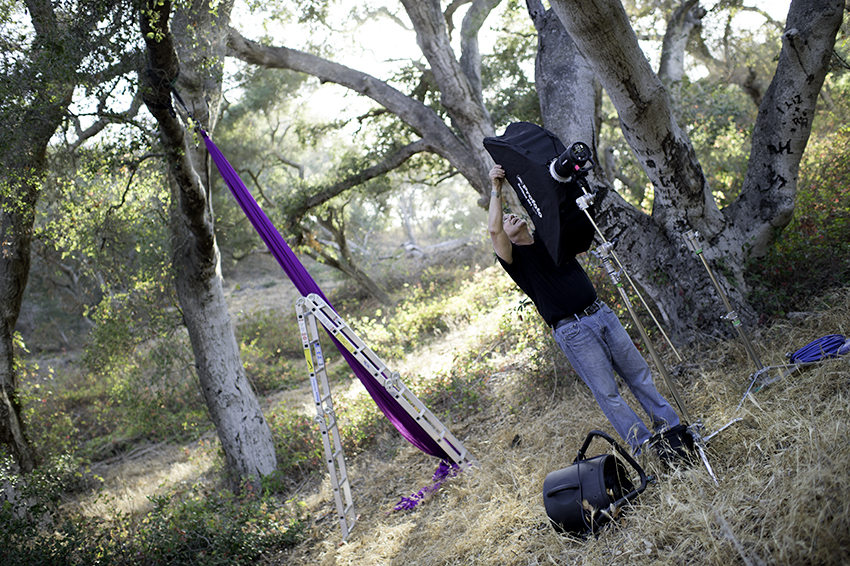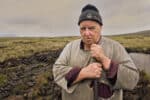 I recently was fortunate enough to be allowed to play with a beta version of the Profoto Air Remote TTL-N units. That means, in short, the Nikon version of controllers for the already renowned Profoto B1 units. The Canon models have been out for a while, and now the remote for Nikon hits the market on Sept. 15. Hit this link for the complete skinny and specs.
I recently was fortunate enough to be allowed to play with a beta version of the Profoto Air Remote TTL-N units. That means, in short, the Nikon version of controllers for the already renowned Profoto B1 units. The Canon models have been out for a while, and now the remote for Nikon hits the market on Sept. 15. Hit this link for the complete skinny and specs.
So, here’s the good news. My first frame shot with the unit was bang on in terms of exposure. (Which I figured was pretty good, as, it being the first time in the field with them, I really didn’t know what I was doing, or what to expect.) But, despite my first time fumbling, the unit had an exposure lock right out of the gate.
I’ve been asked many times, “Why bother with TTL? Why not just go manual?” Perfectly legitimate questions. There has always been an air of mystery and uncertainty when messing around with TTL. It is the equivalent of opting for a meander in the enchanted forest, staring misty-eyed at the branches and leaves dancing in the wind, instead opting for the chainsaw efficiency and known end result of the lumber yard.
And I live in the manual world, quite often. (Don’t tell Hobby!) Always a good option. But, back at the dawn of TTL, when I started to stand upright, and looked down to discover I actually had opposable thumbs, the whole idea of flashes talking to each other, and the camera, was quite intriguing. I had been through the Vivitar wars (no one survived) trying to make “yellow mode” work as I chased Cher out of Studio 54 into her limo. I had developed a pretty intuitive sense of f-stop relative to the nuclear blast of some of the potato masher flashes I grew up with. (Sunburned subjects, anyone?) I was also reasonably quick about doing long division with guide numbers in my head as I was trying to conjure a composition.
But Christ, it was a lot of hoohah and seemingly unnecessary work! So, when the TTL sun came up over the primordial swamp where I had been sitting in the ooze, eating bugs and waiting for my fins to become legs, I was appreciative. It all started with the Nikon SB-24, which got it right about as often as the Knicks have made it to the NBA finals in the last 20 or so years, but held the maddeningly elusive prospect of an intuitive flash future. Fast forward to now and the SB 910, which gets it right most of the time, and you can see we’ve come aways.
And now, another part of the journey. Bigger flash, done TTL. The Profoto B1 has taken the market by storm, and rightly so. It is a simply, beautifully engineered light. And now, coupling it with through the lens exposure technology, which is now integrated into the already rock solid, dependable Air Remote signaler, well, for me, it’s just about cause to skip and go naked.
For my test, I went into the woods out in San Diego, and hung the beautiful ballerina Jennifer Curry Wingrove from a tree. (I mean, why wouldn’t you?) Jen is a great sport who once went on pointe for me on the counter of a diner in Coronado. She runs a pilates training studio in San Diego now, called Pilates on Park, and has added silk flying to her repertoire of skills.
First job was to get the damn silk in the tree. I’m not exactly Peter Pan anymore, but on location, if I need to get something done that on the face of it appears to be remarkably stupid, I tend to do it myself. So, up the ladder and onto the tree branch (a substantial tree branch, I might add) I went.
I was confident though, as I had the redoubtable tandem of Rob Stephen of Photo Monkey in San Diego, and the maestro of rock and roll, Alan Hess, holding the ladder.
Then, I just do what I usually do in the field. I move things around until they start to make sense. Or don’t make sense. Out here in the woods, I wasn’t up for blending things and making the forest look like a slightly accelerated version of itself. I put warming gels on my background lights, and lit up some trees and grass, just to play with the flashes and draw down what would have been a completely colorless sky. Reality was not my objective here. The inputs the flashes are making into the scene are not subtle, or reality based.
Here’s the basics of where we started:
- Camera Body and lens? Nikon D4S + 24-70 AF-S lens
- How Many Lights? 4 B1’s total
- 1 – Main Light with a RFi Box as Key light positioned @15-20 ft away from subject on a stand, @ 15 ft high. Soft box was a 1’x3′ strip light with an egg crate to control the spill of light.
- 1 – Background Light positioned behind subject on the trail about 30 ft away on a stand, @4 ft high
- 1 – Side light camera right on a baby stand, @40 ft from the tree it was lighting
- 1 -One on the ground camera right, @ 20′ from object it is lighting, i.e., tree trunk. This unit moved around to different positions, as I experimented. It eventually moved to accompany the first background light, giving me a substantial pop of light deep in the frame, behind the trees.
We dragged a generator and wind machine out there with us, which ended up not working out. The existing wind and heaviness of the silks defeated us. Things moved around a bit as we tweaked things here and there, but this is where we started.
Again, the good news is our main problems were the bugs, the poison sumac, the encroaching darkness and trundling a generator a half mile into the woods and not using it. The lights worked great. I was happy to see they responded in very similar fashion to my Nikon speed lights. On the pro camera bodies, in the Nikon system, there is a checkoff (E4) where you can dictate to the camera to integrate your TTL flash computations for “background only” or “entire frame.” This allows you to direct the flash compensation independently from the EV inputs on the camera. The B1’s behaved the same way. (The new version of the D800 camera, the D810, now has this feature as well, thank goodness.)
Rob and Alan proved adept at tossing the silks into the air, which is where we ended up, after the wind machine proved to not have enough oomph.
There’s lots of experimenting to do with these and the possibilities for the future are pretty endless. But, across the board, these units rock. Battery life is excellent. The design of both the flash and the remote is simple and straightforward. The TTL response was predictable, and controllable. I had control of all three zones, and they all responded to commands. This is exciting stuff, and there is definitely more tk here…….






















Joe
As a kid did you climb on everything? I have this image if you stacking the chairs and furniture to get to the highest point. Teetering on the edge.
Bill Bogle Jr.
Cool. I can’t wait. I have my TTL-N pre-ordered and could use it for a shoot in Nashville on 9/5 – 9/9 but sadly it won’t be “available” until 9/15. can I borrow yours? 🙂
Joe,
Great read! Joe can you provide a source for the silks you use.
Thanks…Don
Spectacular, as always!
Not too sure about the naked thing though…..
Good job Joe!
I have some problems to use external flashs over 1/250s of sync speed with my D300s and D700, sing SU-800 or Cactus V5. Cactus dont sync over 1/250s and SU-800 fails a lot of time. Other times, it’s slow and I loss “the time” of the click…
With Prophoto, can I sync the flashs over 1/250s with a reability response?
It’s possible for you do some tests with fast subjects with sync speed 1/500s or fast?
I take photos of equestrian events and on barrel races and I need a reability solution to freeze the horses turning the barrels. If you can, helpme!
Thanks
Hi Joe, does this mean I can have your Quadra…?
In all seriousness, I guess the cost compared to the Quadra’s is pretty appealing. I’m currently using the Odin system & SB910’s – radioed TTL performance is pretty good with these things ( I’ve been wait for Nikon to introduce a radio trigger too long ).
Like to here much more about the B1’s & TTL in the field, thanks…
Marcelo
Have you looked into the Paul C Buff Einstein’s? I’m using the White Lighitng Ultra with a Pocket Wizard Mini TT1 and can get good results up too 1/800 sec after proper setup. And yes I have shot at 1/2000 with no black line.
I have used the B1’s for Canon, but OMG they cost big money. And I hate to say it but thought the knob for the tilt of the unit was a little cheap. Now I have heard from the Canon fan base that Profoto is working on high speed sync. I still like the B1’s and they look great along side Nikon cameras. And if you buy hard to beat the value of the Profoto RFi line of soft boxes.
Joe you could use candles and get great results.
Peter
Pro foto B1 looks good as TTl ex poser.Very turf experiment.
@Marcelo
Yes, the Profoto triggers are the fastest ones in the industry now, just don’t get the TTL-C/N version as it would be useless, just get a pair of Air Sync’s and they’ll sync the fastest out of all.
Interesting stuff Joe, thanks for sharing. I have been training myself to strictly use manual mode with my D300 along with manually adjusting the power to my strobes. I am doing this mainly because I can’t get reliability out of the TTL setting. Maybe I will revisit TTL if I have a chance to play around with this new Nikon equipment.
Have a good day!
Brant
http://theworldthrubrantseyes.blogspot.com
@Brant_and_Pinky
Thanks for the review Joe, these look like exactly what I am in need of, I hate fumbling about in menus using CLS and gate the tiem it takes to manually adjust …. these will be awesome!!
That’s a amazing work.. every photo take it very head work…
Best of luck buddy..
what a nice collection of photos. I am also very lover of photography.
I am not a big fan of heights but these photos were impressive. I loved the idea of the ballerina hanging on silks and I absolutely adored how she stands tall atop the diner counter.
“On the pro camera bodies, in the Nikon system, there is a checkoff (E4) where you can dictate to the camera to integrate your TTL flash computations for “background only” or “entire frame.” This allows you to direct the flash compensation independently from the EV inputs on the camera”
That must be a D4/D4s thing? It’s certainly not on the D3s?
Ah, looked it up.
It’s D4/D4s and a few recent others only.
De-couples the Flash Exposure Comp from the global Exposure comp when set to ‘Background.’
It is a shame that Profoto went down the ratio route after they spent so much time allegedly reverse engineering the Nikon CLS.
Ratios are old fashioned and ok for some studio work but not very effective when working on location as these lights are so obviously advertised.
Why not just have the Air TTL adjust the power of the selected strobe NOT it’s relationship with the other B1’s? In camera FEC? Sure, if you have it on the newer Nikon’s. If you don’t you are globally adjusting in the semi-auto modes. Yuk!
There are two work arounds, for multiple B1’s, take a frame in TTL mode then immediately switch to manual and you are adjusting power of each strobe group, not ratio- just like the CLS. (no power reading shows on the Air Remote though in manual mode, heaven knows why!)
For a single B1, use camera in manual mode and use the global exposure compensation . It will only affect the flash in this situation and you can take the power up or down.
Ratio’s? bleeuuuugh! Bad move Profoto. Was the Nikon CLS that tough to crack!?
Why would my comments on the tech side of things not be approved? No free speech here?
Nope, just came in at D4 time. Not available in D800 either. But thankfully, thankfully, we have it now for D810, as well as D4 and D4S. Seems like a small thing, but if you are flash shooter, it’s a pretty big deal.
It sure is a big deal if you want to really work with TTL!
Guess it’s time replace my D3S’s!
As great as the B1’s are, just disappointed that Profoto didn’t really mimic the Nikon CLS. It’s no way a deal breaker I just think that they could have built the FEC into to the new Air Remote….
With all the setup involved in these shots I can’t quite see how TTL has offered anything, but a potential slight variance from shot to shot that ALL auto systems will incur. This could easily have been shot without TTL and with total consistency. TTL is what you use with rapid random captures, otherwise with a controlled setup TTL is technology for Technology sake. Battery powered portable studio flash on the other hand is fantastic.
Yep, I hear ya. Big setups for me are generally manually driven. But our mission of the day, outside of making a good pic, was to test the TTL systems. There were still in beta at the time, and we were pushing and pulling them to see how they worked.
Nice review. I love how you describe things in a simple fashion. I would love you to do a review of the Phottix Indra 500. Same features as the B1 except battery pack and alms or half the price.
I’ve just got the Profoto B2 with Air Remote TTL Nikon. My first test yesterday using TTL mode (D810): images are mostly app. 1.5 stop overexposed. “On the pro camera bodies, in the Nikon system, there is a checkoff (E4) where you can dictate to the camera to integrate your TTL flash computations for “background only” or “entire frame.” This allows you to direct the flash compensation independently from the EV inputs on the camera”
Don’t know that before. Is using “background only” a way to solve this problem?
Yes, give that a try, it’s a way to isolate the TTL computation from the scene, or include it….
Thanks!! I’ll try it.